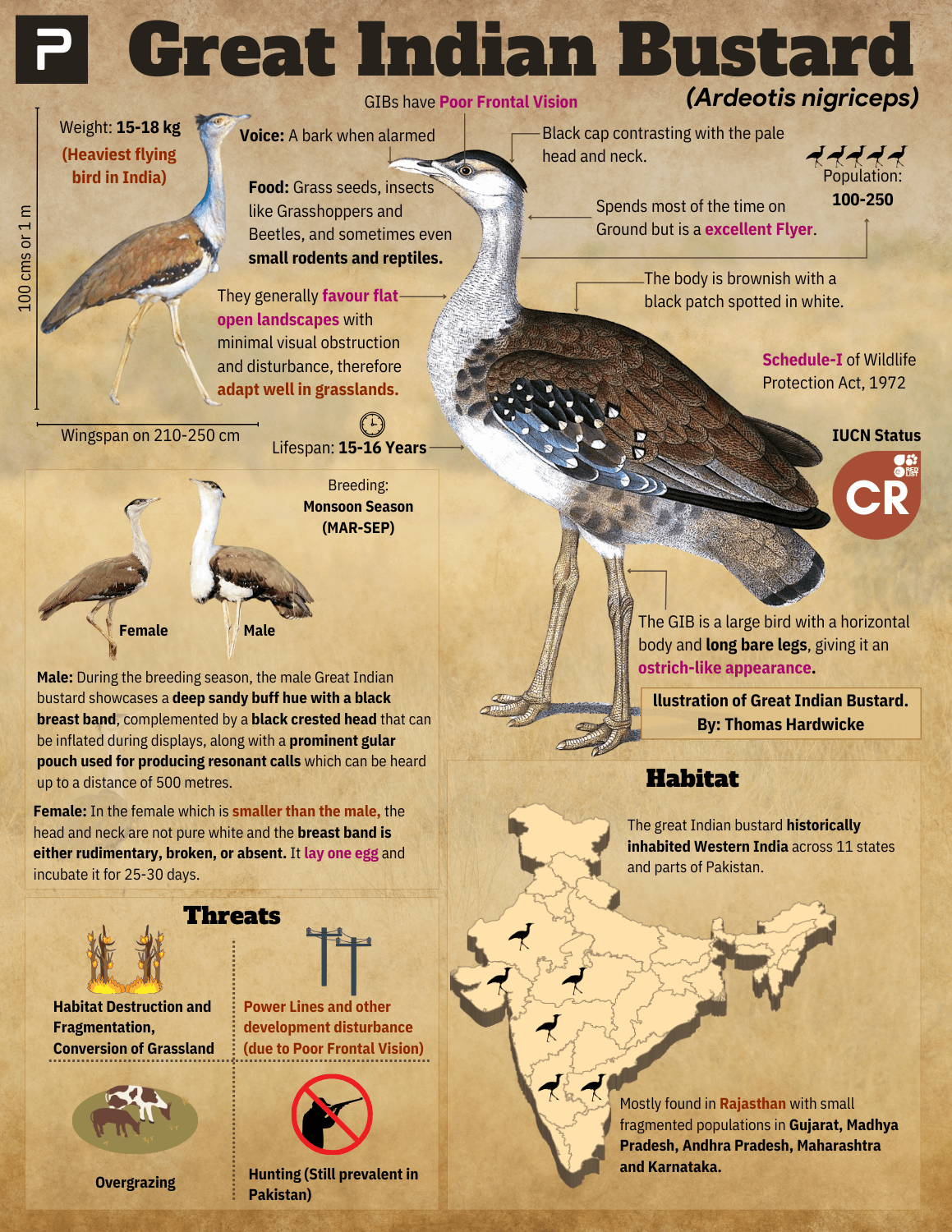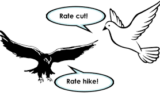
Great Indian Bustard
Subscribers of "Current Affairs" course can Download Daily Current Affairs in PDF/DOC
Subscribe to Never Miss an Important Update! Assured Discounts on New Products!
Must Join PMF IAS Telegram Channel & PMF IAS History Telegram Channel
- Context (TH | HT): Supreme Court seeks centre’s views on balancing the preservation of Great Indian Bustard with India’s solar energy needs.

- The Great Indian bustard is a large bird with a horizontal body and long bare legs, giving it an ostrich-like appearance.
- Endemic to the Indian subcontinent, they are one of the heaviest-flying birds in the world.
- It is considered the flagship grassland species, representing the health of the grassland ecology.
- They are the largest among the four bustard species (Houbara bustard, Lesser florican, Bengal florican & Great Indian Bustard) found in India.
- They are primarily terrestrial birds. They spend most of their time on the ground with occasional flights to travel from one place to another.
- They are diurnal birds, usually active in the early morning and evening hours.
- It is the state bird of Rajasthan.

Distribution
- They were formerly found across the Indian Subcontinent, but they are now locally extinct in 90% of its original range.
- In India, they are found scattered throughout the Indian states of Rajasthan, Gujarat, Maharashtra, Andhra Pradesh, Karnataka.
- They inhabit dry and semi-dry grasslands with dispersed bushes and patches of scrub.

Diet
- They are omnivores, feeding on insects, grass seeds, berries, rodents and reptiles.
- In cultivated areas, they feed on crops such as exposed groundnut, millets, & pods of legumes.
Physical features
- They can easily be distinguished by their black crown on the forehead, contrasting with the pale neck and head.
- Males have larger crowns as compared to the females.
- Males and females are distinguished by the colour of their feathers.
Conservation Status
- IUCN: Critically Endangered.
- CITES: Appendix I.
- WPA 1972: Schedule I.
Threats
- Slow reproductive rate: It lays one egg every 1-2 years, and the success rate of these eggs under ideal situations is around 60-70%.
- Habitat loss/degradation due to development activities like mining, industries, wind turbines, and associated infrastructure growth.
- Noise pollution interfering with the GIB’s mating call.
- Hunting and poaching.
- Free-ranging dogs.
- Erosion of support from local communities.
Recent Developments
- Context (IE): SC will review its April 2021 order to bury underground all power lines in the habitat of the Great Indian Bustard (GIB) after the Centre submitted its affidavit.
- In its 2021 order, the SC listed two types of power lines — those that would install bird diverters, and those that would be converted to underground lines, if feasible, within a year.
- A summary cost estimate put the total expenses of installing bird diverters across 1,342 km and undergrounding 104 km at approx Rs 150 crore.
Centre’s Arguments
- As per the GoI, taking lines of 66 KV and higher voltage underground was not feasible for the evacuation of bulk power due to constraints such as transmission losses, maintenance challenges, multiple cable joints, increased time requirements, and concerns of safety.
- Further, harnessing renewable power from high-potential areas of Rajasthan and Gujarat was “essential for meeting rising power demand and India’s international commitments on climate change”.
Impact of power lines on GIB
- In 2020, a study carried out by the Wildlife Institute of India in and around Desert National Park in Rajasthan estimated that power lines killed around 84,000 birds of multiple species every year.
- GIBs are especially vulnerable because of their narrow frontal vision and large size.
- Unlike some birds that have a panoramic vision around the head, species like raptors and bustards have extensive blind areas above their heads.
- They cannot detect power lines ahead of them from far. As they are heavy birds, they are unable to manoeuvre across power lines within close distances.
Conservation Measures
- Project Great Indian Bustard announced by Rajasthan Government in 2018.
- Centres for breeding and hatching established in Jaisalmer and Kota.
- Constitution of the Bustard Task Force and the development of the National Guidelines for Recovery of Resident Bustards.
- Wildlife Institute of India (WII) launched the project “Habitat Improvement and Conservation Breeding of Great Indian Bustard: An Integrated Approach” in collaboration with MoEFCC, State Forest Departments and NGO partners.
- Objective: To build up captive population of Great Indian bustard and to release the chicks in the wild to increase the population.
- MOEFCC provides financial assistance to the States/ UTs under the Centrally Sponsored Scheme: Development of Wildlife Habitats for conservation of wildlife, including for Great Indian Bustard.







![PMF IAS Environment for UPSC 2022-23 [paperback] PMF IAS [Nov 30, 2021]…](https://pmfias.b-cdn.net/wp-content/uploads/2024/04/pmfiasenvironmentforupsc2022-23paperbackpmfiasnov302021.jpg)











